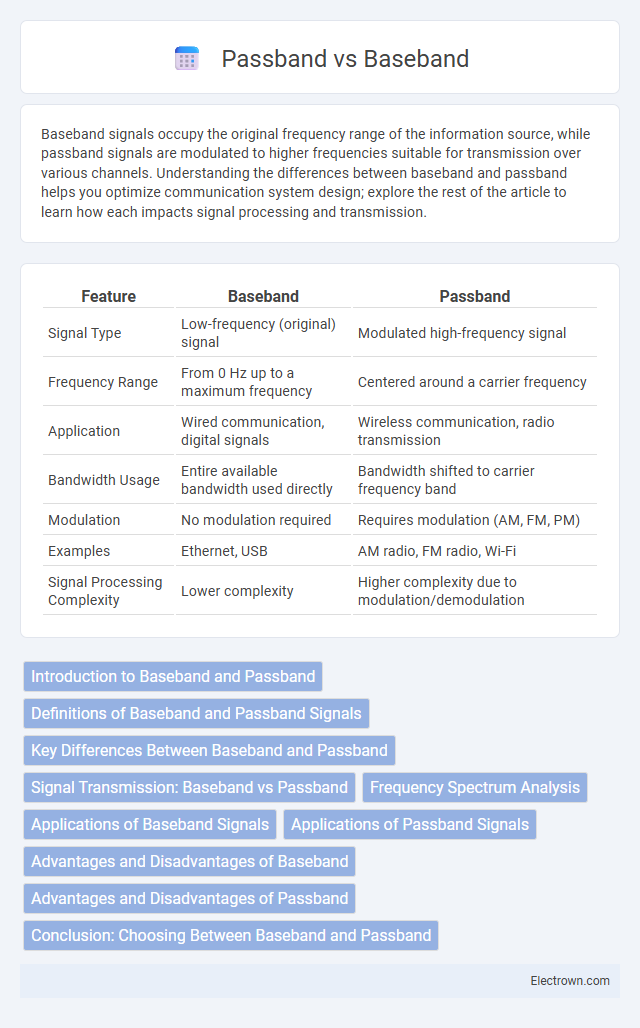Baseband signals occupy the original frequency range of the information source, while passband signals are modulated to higher frequencies suitable for transmission over various channels. Understanding the differences between baseband and passband helps you optimize communication system design; explore the rest of the article to learn how each impacts signal processing and transmission.
Table of Comparison
| Feature | Baseband | Passband |
|---|---|---|
| Signal Type | Low-frequency (original) signal | Modulated high-frequency signal |
| Frequency Range | From 0 Hz up to a maximum frequency | Centered around a carrier frequency |
| Application | Wired communication, digital signals | Wireless communication, radio transmission |
| Bandwidth Usage | Entire available bandwidth used directly | Bandwidth shifted to carrier frequency band |
| Modulation | No modulation required | Requires modulation (AM, FM, PM) |
| Examples | Ethernet, USB | AM radio, FM radio, Wi-Fi |
| Signal Processing Complexity | Lower complexity | Higher complexity due to modulation/demodulation |
Introduction to Baseband and Passband
Baseband signals occupy the original frequency range starting from near zero Hz and are typically used for digital data transmission within short distances. Passband signals are modulated onto a higher frequency carrier wave to enable transmission over longer distances and through various media, making them essential for wireless and radio communications. Your choice between baseband and passband depends on the application requirements such as distance, bandwidth, and channel characteristics.
Definitions of Baseband and Passband Signals
Baseband signals refer to signals whose frequency content is concentrated near zero frequency, typically ranging from DC up to a certain maximum frequency, making them ideal for direct transmission over a physical medium. Passband signals, on the other hand, are modulated signals whose frequency content is shifted to a higher frequency range, known as the carrier frequency, allowing for efficient transmission over long distances and enabling frequency-division multiplexing. Understanding the distinction between baseband and passband signals is crucial for designing communication systems, including modulation techniques and signal processing methods.
Key Differences Between Baseband and Passband
Baseband signals occupy the original frequency range starting from near zero Hz, ideal for short-distance communication and digital data transmission, while passband signals are modulated to higher frequency bands for long-distance and wireless communications. Baseband transmission uses simple modulation schemes with lower bandwidth requirements, whereas passband requires complex modulation techniques, enabling multiplexing and better noise resilience. The key distinction lies in the frequency spectrum each occupies; baseband remains in the low-frequency range, and passband shifts to a higher frequency, facilitating effective transmission over various media.
Signal Transmission: Baseband vs Passband
Baseband signal transmission involves sending a low-frequency or zero-frequency signal directly over a channel without modulation, making it ideal for short-distance communication such as Ethernet networks. Passband transmission modulates the baseband signal onto a higher frequency carrier wave, enabling long-distance data transfer over radio waves, optical fibers, or coaxial cables. This modulation allows efficient usage of available bandwidth and reduces interference in wireless and broadband communication systems.
Frequency Spectrum Analysis
Baseband signals occupy the frequency range starting from near zero up to a certain maximum frequency, allowing direct transmission without modulation, making them ideal for short-distance communications and digital data. Passband signals shift the baseband signal to a higher frequency range within the frequency spectrum through modulation, enabling efficient use of bandwidth and long-distance transmission over various media such as radio waves. Understanding the frequency spectrum analysis of baseband versus passband is crucial for optimizing your communication system's bandwidth allocation and signal integrity.
Applications of Baseband Signals
Baseband signals are primarily used in digital communication systems such as Ethernet and local area networks (LANs), where data transmission occurs over short distances without modulation to higher frequencies. They are ideal for applications requiring high data integrity and low latency, including computer networking and wired telecommunication systems. Baseband signaling is also crucial in audio and video signal processing, enabling direct transmission of raw data for quality preservation and ease of signal manipulation.
Applications of Passband Signals
Passband signals are widely used in wireless communications, enabling data transmission over radio frequencies for applications such as mobile phones, Wi-Fi, and satellite systems. These signals modulate baseband data onto higher frequency carriers, allowing efficient long-distance propagation and frequency multiplexing. Your choice of passband technology can significantly impact signal range, bandwidth efficiency, and interference management in modern communication networks.
Advantages and Disadvantages of Baseband
Baseband transmission offers high data integrity and simpler signal processing, making it ideal for short-distance communication such as within Local Area Networks (LANs). Its main disadvantages include susceptibility to noise and limited range due to the use of low-frequency signals that cannot travel long distances without signal degradation. Baseband systems also require more complex wiring and cannot efficiently share the medium among multiple users without additional protocols like Time Division Multiplexing (TDM).
Advantages and Disadvantages of Passband
Passband transmission enables signals to be transmitted over long distances with higher frequency ranges, making it ideal for wireless communication and radio broadcasting. The advantages of passband include efficient use of bandwidth, reduced interference, and the ability for multiple signals to coexist through techniques like frequency division multiplexing (FDM). However, passband systems can be more complex and costly to implement, and signal distortion due to fading and noise can be challenging to manage in certain environments.
Conclusion: Choosing Between Baseband and Passband
Choosing between baseband and passband depends on the application requirements such as bandwidth efficiency, transmission distance, and channel characteristics. Baseband transmission suits short-range communication with simpler hardware, while passband transmission is optimal for long-range wireless communication and frequency multiplexing. Evaluating factors like signal attenuation, noise resilience, and regulatory constraints ensures the selection aligns with system performance goals.
Baseband vs Passband Infographic

 electrown.com
electrown.com